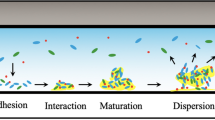Abstract
Magnetotactic bacteria are microorganisms that produce intracellular magnetic nanoparticles organized in chains, conferring a magnetic moment to the bacterial body that allows it to swim following the geomagnetic field lines. Magnetotactic bacteria usually display two swimming polarities in environmental samples: the South-seeking (SS) polarity and the North-seeking (NS) polarity, characterized by the bacteria swimming antiparallel or parallel to the magnetic field lines, respectively. It has been observed that in the presence of inhomogeneous magnetic fields, NS magnetotactic bacteria can change their swimming polarity to SS or vice versa. The present study analyzes populations of NS cocci obtained from SS cocci isolated in the presence of a magnet. The aim was to study differences in the swimming characteristics and magnetic moment among both populations of cocci. For that, trajectories were recorded and the velocity and angle among the velocity and the applied magnetic field were calculated. In addition, micrographs from both SS and NS cocci were obtained and their magnetosomes were measured to analyze their length, width, aspect ratio and magnetic moment, to finally obtain the magnetic moment for each coccus. The results showed the following properties of NS relative to SS cocci: higher velocities, narrow bacterial magnetic moment distribution, higher dispersion in the distribution of angles among the velocity and the applied magnetic field and lower magnetic field sensibility. Those differences cannot be explained by the simple change in magnetic polarity of the magnetosome chain and can be related to the existence of an active magnetoreceptive process in magnetotactic bacteria.





Similar content being viewed by others
References
Abreu F, Acosta-Avalos D (2018) Biology and physics of magnetotactic bacteria. In: Blumenberg M, Shaaban M, Elgaml A (eds) Microorganisms. IntechOpen, London, pp 1–19
Acosta-Avalos D, Figueiredo AC, Conceição CP, da Silva JJP, Aguiar KJMSP, Medeiros ML, Nascimento M, De Melo RD, Sousa SMM, Lins de Barros H, Alves OC, Abreu F (2019) U-turn trajectories of magnetotactic cocci allow the study of the correlation between their magnetic moment, volume and velocity. Eur Biophys J 48:513–521
Bazylinski DA, Frankel RB (2004) Magnetosome formation in prokaryotes. Nat Rev Microbiol 2:217–230. https://doi.org/10.1038/nrmicro842
Blakemore RP (1982) Magnetotactic bacteria. Ann Rev Microbiol 36:217–238
Blakemore RP, Frankel RB, Kalmijn AJ (1980) South-seeking magnetotactic bacteria in the Southern hemisphere. Nature 286:384–385
Carvalho AL, Abreu F, Acosta-Avalos D (2021) Multicellularity makes the difference: multicellular magnetotactic prokaryotes have dynamic motion parameters dependent on the magnetic field intensity. Eur Phys J plus 136:203. https://doi.org/10.1140/epjp/s13360-021-01187-4
Chang J, Yi H, Koo HC, Mironov VL, Gribkov BA, Fraerman AA, Gusev SA, Vdovichev SN (2007) Magnetization reversal of magnetic nanoparticles under inhomogeneous magnetic field. J Mag Mag Mater 309:272–277. https://doi.org/10.1016/j.jmmm.2006.07.015
De Melo RD, Acosta-Avalos D (2017) The swimming polarity of multicellular magnetotactic prokaryotes can change during an isolation process employing magnets: evidence of a relation between swimming polarity and magnetic moment intensity. Eur Biophys J 46:533–539. https://doi.org/10.1007/s00249-017-1199-5
De Melo RD, Leão P, Abreu F, Acosta-Avalos D (2020) The swimming orientation of multicellular magnetotactic prokaryotes and uncultured magnetotactic cocci in magnetic fields similar to the geomagnetic field reveals differences in magnetotaxis between them. Antonie Van Leeuwenhoek 113:197–209. https://doi.org/10.1007/s10482-019-01330-3
Frankel RB, Blakemore RP (1980) Navigational compass in magnetic bacteria. J Mag Mag Mat 15–18:1562–1564
Gonzalez LM, Ruder WC, Mitchell AP, Messner WC, LeDuc PR (2015) Sudden motility reversal indicates sensing of magnetic field gradients in Magnetospirillum magneticum AMB-1 strain. ISME J 9:1399–1409
Leão P, Teixeira LCRS, Cypriano J, Farina M, Abreu F, Bazylinski DA, Lins U (2016) North-seeking magnetotactic gammaproteobacteria in the Southern hemisphere. Appl Environ Microbiol 82:5595–5602. https://doi.org/10.1128/AEM.01545-16
Lefevre CT, Song T, Yonnet JP, Wu LF (2009) Characterization of bacterial magnetotactic behaviors by using a magnetospectrophotometry assay. App Environ Microbiol 75:3835–3841. https://doi.org/10.1128/AEM.00165-09
Lins U, Freitas F, Keim CN, Lins de Barros H, Esquivel DMS, Farina M (2003) Simple homemade apparatus for harvesting uncultured magnetotactic microorganisms. Braz J Microbiol 34:111–116
Penninga I, de Waard H, Moskowitz BM, Bazylinski DA, Frankel RB (1995) Remanence measurements on individual magnetotactic bacteria using a pulsed magnetic field. J Magn Magn Mater 149:279–286
Philippe N, Wu LF (2010) An MCP-like protein interacts with the MamK cytoskeleton and is involved in magnetotaxis in Magnetospirillum magneticum AMB-1. J Mol Biol 400:309–322
Popp F, Armitage JP, Schuler D (2014) Polarity of bacterial magnetotaxis is controlled by aerotaxis through a common sensory pathway. Nat Commun 5:5398
Simmons SL, Bazylinski DA, Edwards KJ (2006) South-seeking magnetotactic bacteria in the Northern hemisphere. Science 311:371–374
Yan L, Zhang S, Chen P, Liu H, Yin H, Li H (2012) Magnetotactic bacteria, magnetosomes and their application. Microbiol Res 167:507–519
Zhang WJ, Chen C, Li Y, Song T, Wu LF (2010) Configuration of redox gradient determines magnetotactic polarity of the marine bacteria MO-1. Environ Microbiol Rep 2:646–650
Zhu X, Ge X, Li N, Wu LF, Luo C, Ouyang Q, Tu Y, Chen G (2014) Angle sensing in magnetotaxis of Magnetospirillum magneticum AMB-1. Integr Biol 6:706
Funding
Giovanni Angiolillo acknowledges financial support from the “Programa de Capacitacão Institucional”-PCI program of the Brazilian agency Conselho Nacional de Desenvolvimento Científico e Tecnológico – CNPq. Fernanda Abreu acknowledges CNPq, CAPES and FAPERJ funding agencies. We thank the microscopy facilities CENABIO-UFRJ and UniMicro-UFRJ.
Author information
Authors and Affiliations
Corresponding author
Ethics declarations
Conflict of interest
The authors have no relevant financial or non-financial interests to disclose.
Additional information
Publisher's Note
Springer Nature remains neutral with regard to jurisdictional claims in published maps and institutional affiliations.
Rights and permissions
Springer Nature or its licensor (e.g. a society or other partner) holds exclusive rights to this article under a publishing agreement with the author(s) or other rightsholder(s); author self-archiving of the accepted manuscript version of this article is solely governed by the terms of such publishing agreement and applicable law.
About this article
Cite this article
Angiolillo, G., Abreu, F. & Acosta-Avalos, D. Swimming polarity inversion in uncultured magnetotactic cocci. Eur Biophys J 53, 69–76 (2024). https://doi.org/10.1007/s00249-023-01698-1
Received:
Revised:
Accepted:
Published:
Issue Date:
DOI: https://doi.org/10.1007/s00249-023-01698-1




